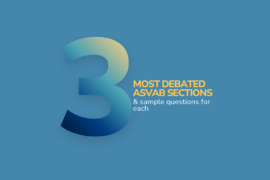Flashcards are an incredibly versatile study tool. While many students think of using them for simple facts, they can be used for complex processes throughout one’s academic career.
“Flashcards give your brain a very quick way to check if you got the answer correct. Grading your own work is an act of self-reflection which deepens memory,” said Elizabeth Barry, Director of Marketing at Peterson’s. “Scientists refer to this as metacognition.”
They also help you engage in active recall which teaches your brain to remember a term, concept, or process without context clues. By learning something in this way, stronger neuron connections form in your brain because it is more difficult for your brain, making it more likely to remember the information in the future. And, flashcards allow you to repeat the act of learning and memorizing until you are an expert on the information. The age-old concept of “practice makes perfect” is absolutely true when it comes to studying.
While flashcards an extremely effective studying tool, most students don’t know how to maximize their impacts. Liam Powers, Vice President and CCO of the Tutoring Club, explained this phenomenon in terms of the academic stages a student undergoes.
“When students are five to eight years old, they start to really adapt to memorization because they’re really rewarded for that when it comes to spelling tests and in other things that are math fact test-based. So in the context of using flashcards for things that are that basic in nature, I feel like a lot of times flashcards are a student’s first introduction to that,” said Powers.
Powers explained that during these younger years, flashcards are heavily used by students until about third grade. After third grade, he has noticed that students don’t engage with flashcards as much until middle school.
“What we will see is when students transition to middle school and when tests become a lot more valuable in terms of their overall grades, students will attempt to utilize flashcards because their teachers will tell them to study. But, a lot of them don’t really know how to study. The earliest inkling they have of studying goes back to flashcards when they were studying for four and five letter word spelling tests or parts of speech and grammar, pretty basic things. And they when they’re 13,14 years old, they’re really trying to adapt to learning more complex materials,” said Powers.
The obstacle for students in this stage is that the information they are trying to learn is too complex for simple flashcard definitions that they learned originally. For example, a student may be taking a European History class in which they will be tested on connecting ideas and concepts, rather than simply names and dates. Powers explained that consequently, many students will try to put far too much material on flashcards which is overly time consuming and may be too detailed for studying.
“However, in the last five to six years there have been online flashcards which are great because a lot of people in this day in age can type at a much faster pace than they can write, so students can utilize this online platform to create their own flashcards or even look up shared material,” said Powers.
Online flashcards cut down the time it takes to create flashcards, whether a student is creating their own cards or not.
Powers encouraged students to utilize flashcards even for major topics by using bulleted talking points as the answer on the backside of the flashcard. For example, a flashcard labeled “American Revolution” is an expansive topic, but the back of the card could simply bullet some key concepts in regard to the topic.
As for using flashcards to their full advantage, Powers shared how he finds a disconnect with students.
“[Students] think okay, I created flashcards so I’m going to look at the front, and then I’m going to look at the back, and I’m going to just keep cycling through that. That’s not effective. The most effective way for students to actually use flashcards, especially in their teenage years when they have a bit more complex material, is they need to create strategy around them,” said Powers.
This strategy revolves around rating your confidence level when answering flashcard questions, which is a feature built into Peterson’s digital flashcards. Whether online or with physical flashcards, students should organize flashcards based on their confidence level.
Powers gave the example of a student is using physical flashcards. If a student is answering a flashcard question and automatically knows the correct answer, this card goes in the first pile. If the student gets the overall concept of the answer but could use more practice, this card goes in the second pile. If a student does not know the answer to the flashcard question, this card goes in a third pile. The student can then utilize the frequency of practicing cards in the third pile in order to increase their confidence levels, moving cards to the second and first piles.
Of course, your quality of flashcards often depends on your quality of notes from which to build the flashcard material. Students should first develop good note taking skills by summarizing the main points of a classroom lecture or lesson, rather than trying to write everything down. Reviewing these notes is also important in retaining the information.
“The most ideal student who’s really adapting to an older age and learning to study more effectively are going to be students who take notes and that same day that they took the notes, they re-read them once or twice to themselves. If they can take it a step further, students can re-write some of those notes by condensing them, and also creating corresponding flashcards especially to the things that are more definition-based and formula-based,” said Powers.
One suggestion Powers had for students to be able to use their flashcards and notes for other forms of studying is to create audio content.
“What we encourage some students to do so that they’re constantly reviewing without too much labor, is to use the voice recorder on their phone to re-read the aspects of their note or the aspects of their flashcards. Then, they can then play these recordings on a loop with their earphones, their airpods, their beats, whatever they use to listen to music normally. Taking some of these ‘old school’ methods like note taking and flashcards and putting them into an audible format gives students more access to the material. Whether that’s on the bus to school, on the walk to school and back, or waiting for practice to start, a lot of this dead time can be filled for a student who cares about their studies,” said Powers.
There are many ways to study, but the traditional methods of note taking and flashcards are the some of the most basic and effective ways. However, these methods can be brought to the 21st century by using digital flashcards and voice recordings. Finding a study style that works for you is key to being motivated and successful in your studies.



